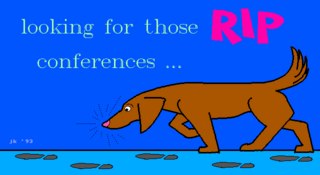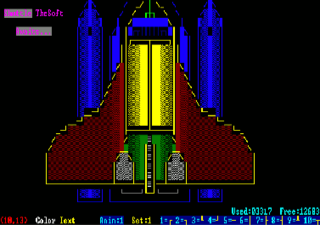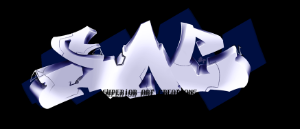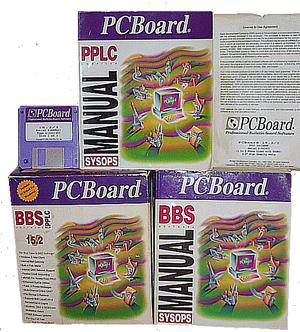Related Research Articles

ASCII art is a graphic design technique that uses computers for presentation and consists of pictures pieced together from the 95 printable characters defined by the ASCII Standard from 1963 and ASCII compliant character sets with proprietary extended characters. The term is also loosely used to refer to text-based visual art in general. ASCII art can be created with any text editor, and is often used with free-form languages. Most examples of ASCII art require a fixed-width font such as Courier for presentation.

A bulletin board system (BBS), also called a computer bulletin board service (CBBS), was a computer server running software that allowed users to connect to the system using a terminal program. Once logged in, the user can perform functions such as uploading and downloading software and data, reading news and bulletins, and exchanging messages with other users through public message boards and sometimes via direct chatting. In the early 1980s, message networks such as FidoNet were developed to provide services such as NetMail, which is similar to internet-based email.
A text file is a kind of computer file that is structured as a sequence of lines of electronic text. A text file exists stored as data within a computer file system. In operating systems such as CP/M and DOS, where the operating system does not keep track of the file size in bytes, the end of a text file is denoted by placing one or more special characters, known as an end-of-file (EOF) marker, as padding after the last line in a text file. On modern operating systems such as Microsoft Windows and Unix-like systems, text files do not contain any special EOF character, because file systems on those operating systems keep track of the file size in bytes. Most text files need to have end-of-line delimiters, which are done in a few different ways depending on operating system. Some operating systems with record-orientated file systems may not use new line delimiters and will primarily store text files with lines separated as fixed or variable length records.
The computer art scene, or simply artscene, is the community interested and active in the creation of computer-based artwork.
4DOS is a command-line interpreter by JP Software, designed to replace the default command interpreter COMMAND.COM in Microsoft DOS and Windows. It was written by Rex C. Conn and Tom Rawson and first released in 1989. Compared to the default, it has a large number of enhancements.

.nfo is a filename extension for text files that accompany warez scene releases of pirated software or media.
ANSI art is a computer art form that was widely used at one time on bulletin board systems. It is similar to ASCII art, but constructed from a larger set of 256 letters, numbers, and symbols — all codes found in IBM code page 437, often referred to as extended ASCII and used in MS-DOS and Unix environments. ANSI art also contains special ANSI escape sequences that color text with the 16 foreground and 8 background colours offered by ANSI.SYS, an MS-DOS device driver loosely based upon the ANSI X3.64 standard for text terminals. Some ANSI artists take advantage of the cursor control sequences within ANSI X3.64 in order to create animations, commonly referred to as ANSImations. ANSI art and text files which incorporate ANSI codes carry the de facto.ANS file extension.

The Initial Graphics Exchange Specification (IGES) is a vendor-neutral file format that allows the digital exchange of information among computer-aided design (CAD) systems. It's an ASCII-based textual format.

The Remote Imaging Protocol and its associated Remote Imaging Protocol Script language, RIPscrip, is a graphics language that provides a system for sending vector graphics over low-bandwidth links, notably modems. It was originally created by Jeff Reeder, Jim Bergman, and Mark Hayton of TeleGrafix Communications in Huntington Beach, California to enhance bulletin board systems and other applications.

TheDraw is a text editor for MS-DOS to create ANSI and animations as well as ASCII art. The editor is especially useful to create or modify files in ANSI format and text documents, which use the graphical characters of the IBM ASCII code pages, because they are not supported by Microsoft Windows anymore. The first version of the editor was developed in 1986 by Ian E. Davis of TheSoft Programming Services. The last public version of the editor was version 4.63, which was released in October 1993.

Superior Art Creations (SAC) is an underground artscene group which caters primarily to and is well known within the warez scene. SAC members have made, besides ANSI and ASCII art, VGA bitmap graphics, tracker music, and a variety of other works. SAC's character graphics have also been used in bottles and FTP servers.
The Humble Guys (THG) were a cracking group for the IBM PC during the late 1980s founded by two friends known by the pseudonyms Candyman and Fabulous Furlough. The group was also noticed in the demoscene for some of their cracktros.

The Warez scene, often referred to as The Scene, is a worldwide, underground, organized network of pirate groups specializing in obtaining and illegally releasing digital media for free before their official sale date. The Scene distributes all forms of digital media, including computer games, movies, TV shows, music, and pornography. The Scene is meant to be hidden from the public, only being shared with those within the community. However, as files were commonly leaked outside the community and their popularity grew, some individuals from The Scene began leaking files and uploading them to filehosts, torrents and ed2k.

PCBoard (PCB) was a bulletin board system (BBS) application first introduced for DOS in 1983 by Clark Development Company. Clark Development was founded by Fred Clark. PCBoard was one of the first commercial BBS packages for DOS systems, and was considered one of the "high end" packages during the rapid expansion of BBS systems in the early 1990s. Like many BBS companies, the rise of the Internet starting around 1994 led to serious downturns in fortunes, and Clark Development went bankrupt in 1997. Most PCB sales were of two-line licenses; additional line licenses were also available.
The C0 and C1 control code or control character sets define control codes for use in text by computer systems that use ASCII and derivatives of ASCII. The codes represent additional information about the text, such as the position of a cursor, an instruction to start a new line, or a message that the text has been received.
QWK is a file-based offline mail reader format that was popular among bulletin board system (BBS) users, especially users of FidoNet and other networks that generated large volumes of mail. QWK was originally developed by Mark "Sparky" Herring in 1987 for systems running the popular PCBoard bulletin board system, but it was later adapted for other platforms. Herring died of a heart attack in 2020 after being swatted. During the height of bulletin board system popularity, several dozen offline mail readers supported the QWK format.
Celerity BBS was a descendant of the freely distributed source of TCS BBS 1.43, and ultimately nearly completely rewritten.
McBBS was a Bulletin Board System developed by Derek E. McDonald and distributed by DMCS Technologies between October 30, 1989 and May 30, 2000 and operated over 18 versions.
GT Power is a bulletin board system (BBS) and dial-up telecommunications/terminal application for MS-DOS. It was first introduced in the 1980s by P & M Software, founded by Paul Meiners. GT Power can be used both to host a BBS as well as to connect to other BBS systems via its full-featured dial-up "terminal mode". GT Power was a shareware package that required a registration fee in order to access its proprietary network mail transport/handling software and, by default, the GT Power Network. The software is distributed in two "flavors": a terminal-only version, nicknamed GTO, and the full-featured host and terminal version.
Aces of ANSI Art was the first group of artists specifically organized for the purposes of creating and distributing ANSI art. The group was founded and operated by two BBS enthusiasts from California, "Zyphril" and "Chips Ahoy", from 1989 through 1991.
References
- ↑ Fong, B. C.; Doyle, D. J. (1995). "Renal function tests for windows — a model for the development and distribution of medical software on the Internet". International Journal of Bio-Medical Computing. 40 (1): 69–75. doi:10.1016/0020-7101(95)01126-Y. PMID 8557407. "Short ANSI text file (31 characters wide) often automatically extracted by Bulletin Board Service programs."
- ↑ White, Ron (July 2001). "Mystery Files". Ziff Davis Smart Business. 14 (7): 100. ISSN 1535-9891.
DIZ stands for Description in Zip.
- ↑ Holler, Richard (1994-05-17). "FILEID.TXT v1.9".
- ↑ Reimerdes, Shawn. "DIZ/2-PCB PPE script for PCBoard, ULBYE100.ZIP".
- ↑ Craig, P.; Honick, R.; Burnett, M. (2005). "The Release". Software Piracy Exposed. p. 95. doi:10.1016/B978-193226698-6/50030-1. ISBN 978-1-93-226698-6.
- ↑ Copy of official FILE_ID.DIZ documentation.
- ↑ Olivier "Tasmaniac" Reubens (2013-11-12). "Standard Architecture for Universal Comment Extensions". ACiD.
- ↑ "Technical Note -- Using DESCRIPT.ION". Chestertown, Maryland, USA: JP Software Inc. 1989. Archived from the original on 2016-03-18. (NB. Known IDs include
0x10for general metadata in XMP format,0x23('#') as used by various utilities written by Matthias R. Paul for space-separated lists of text key=value pairs holding file properties as extended attributes like CP (codepages), PC (language codes), CW (bit-width), XS (page width), YS (page length), XO (print x-offset), YO (print y-offset), CR (copyright), URL (source link), etc.,0x25('%') being used by programs using CUI_LIB to store pseudo-environment variables,0xEDbeing reserved for Digital Research/Novell/Caldera,0xC2used by Total Commander for multiline file descriptions, and0xFDreserved for FreeDOS.)